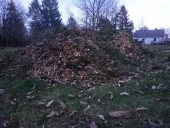




Highland Creamery, micro-dairy & family farm.
https://www.facebook.com/home.php#!/highlandcreamery




Idle dreamer




"You may never know what results come of your action, but if you do nothing there will be no result”
How Permies.com Works
Be Nice
 1
1




Kevin MacBearach wrote:Reason I'm toying with these ideas is because I just don't see pigs as a very sustainable option for the small homesteader. The "pigs on pasture" scenario, while looks nice in the early stages, ultimately looks to me as a way to turn a grass field into a motor-cross track.





Idle dreamer




Tyler Ludens wrote:Walter, do you have an estimate of how many pigs per acre of pasture you stock on average?




Idle dreamer




 2
2




Kyrt Ryder wrote:Indeed, Walter amplifies their growth rate with off-site inputs.
I'd like to know this too Walter, how would your management change without the inputs? Faster rotations, lower stocking rate or just accepting slower growth? [Or some other possibility I haven't considered]
 1
1




Tyler Ludens wrote:Walter, do you have an estimate of how many pigs per acre of pasture you stock on average?
 1
1




Tyler Ludens wrote:I notice the pigs are also fed on dairy products which seem to come from off-site ... One may get an impression that the pigs live only on pasture and farm-raised vegetables, which does not seem to be the case.




Idle dreamer
 1
1




 1
1




Kyrt Ryder wrote:curiosity over whether or not you could obtain that much egg production without inputs on that land base.




Tyler Ludens wrote:I meant in general, one might get the impression that "pasture-raised pigs" might mean the pigs just eat the pasture. This is a topic we've been hashing over in other threads - is it possible to raise animals without outside inputs. There seem to be very few examples, and it is difficult to get details about how much land is needed, what exactly the animals eat, etc.





Idle dreamer




 1
1




Tyler Ludens wrote:This is off topic, I'm sorry, but, what do the chickens eat in the winter?





Idle dreamer
 2
2




Tyler Ludens wrote:Ok, sorry, that was so confusing to me I guess I couldn't figure it out! :p





 1
1





|
Warning! Way too comfortable! Do not sit! Try reading this tiny ad instead:
turnkey permaculture paradise for zero monies
https://permies.com/t/267198/turnkey-permaculture-paradise-monies
|


